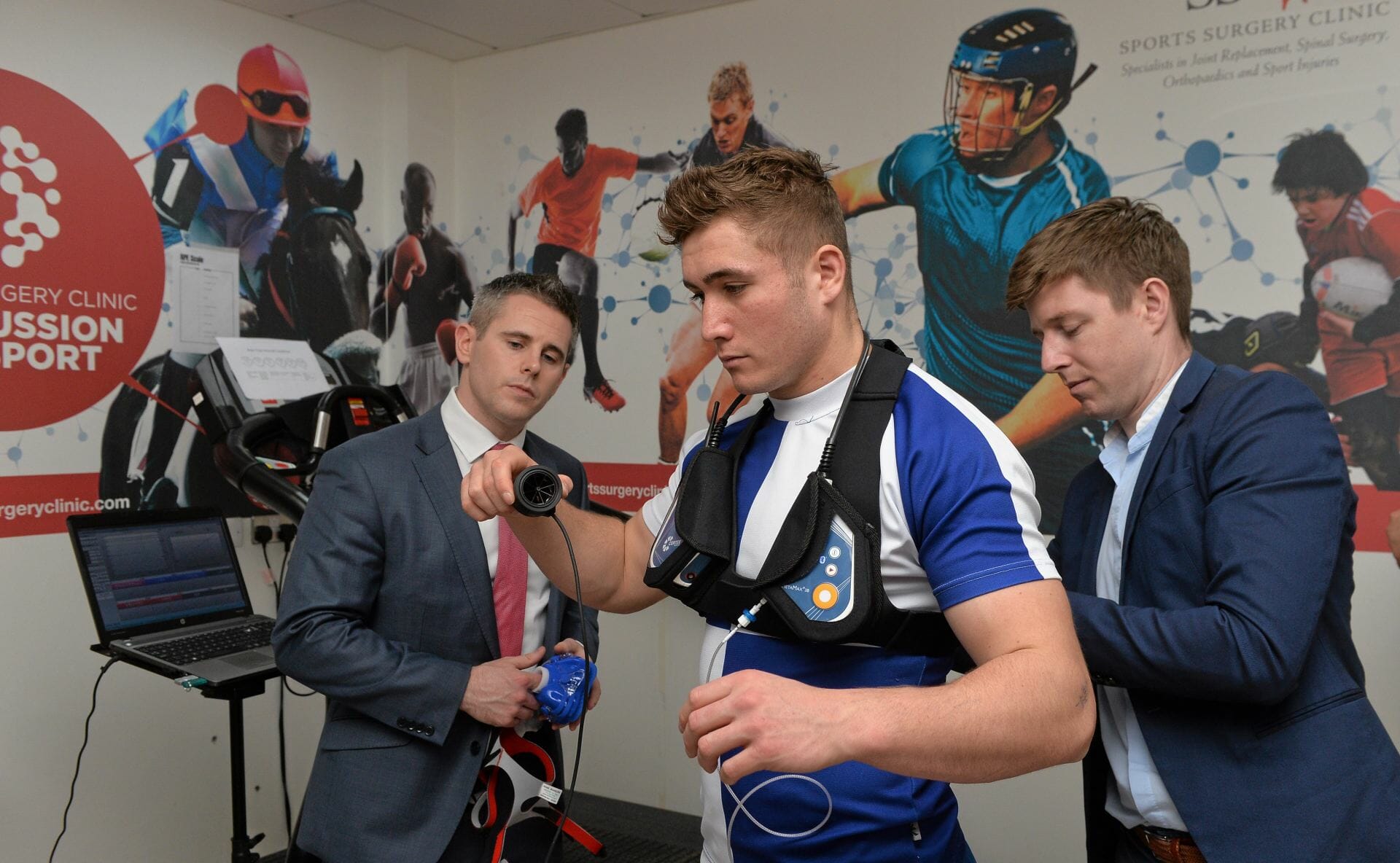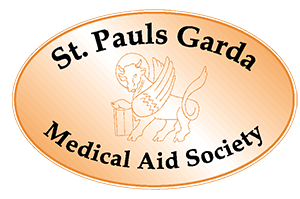Thank you for joining this evening. I am Ann-Maria Byrne. I am a trauma and upper limb surgeon and in UPMC Sports Surgery Clinic I specialise in Elbow, Wrist and Hand surgery. It is a state of the art surgical unit, where we see patients and operate on patients also. I find it a great place to work because I have involvement of a lot of my Sports Medicine colleagues, Physiotherapists and world-class Radiologists as well, and also I have good links with other surgeons who would also deal with sports injuries and things we are going to talk about today. It is one of my favourite places to work.
What I see in my practice is every kind of upper limb injury. Certainly, while the majority of people looking in today will be golfers, you probably do a bit of yoga, you may do some running you may play a bit of tennis as well – and a lot of the injuries we are talking about now will cross over all of these. Of course, when we are looking specifically at the golfers – there are particular injuries that are associated with golfing. While we are mainly talking about the wrist, we can’t ignore the elbow because the wrist and elbow are joined by the forearm and both of them work in tandem. When one is injured it affects the other and vice versa. I always think of it as being a linked joint there between the wrist, elbow and forearm.
What we want to do from this discussion is really look at ways where you can avoid injury and where you can enjoy golf at every stage in your life. I have to say in my defence I am talking today as a surgeon and not a golfer. I do play golf but at a level purely for pleasure rather than for competitiveness – so anybody who is watching who has ever played golf with me or has seen me play golf, remember I am coming from a surgical side this evening. The important thing that we have to think about and look at when we are looking at a golfer is that there is a very specific pattern of swing. You have to take into account obviously the shoulder which we are not talking about today, but the elbow, forearm and the wrist.
The wrist and elbows, each side works in opposite motion paths – one does the opposite of the other. The dominant or trailing upper limb or wrist works more in flexion and extension so its this motion. Whereas the non-dominant, which is the lead wrist and that will be the left side, on a right-handed player, they will be more in rotation, showing rotation, and also ulnar and radial deviation. So when I talk about ulnar sided problems, I am always talking about problems on the little finger side of the wrist and that’s where we see a lot of the injuries on anybody playing golf. I see it in hurlers as well or anybody using a bat or tennis racket or things like that but certainly, in golf, the research has shown that well over 60% of patients will present with ulnar sided wrist pain. And it’s important to take that into account because that is your lead wrist or the non-dominant arm and is related to the biomechanics of the swing, and that’s important in terms of working on your swing physiotherapy later on for upper limb injuries to take that into account.
So the common sites of injury for golfers are obviously what I see the wrist, elbow, shoulder. I don’t look after the neck or lumbar spine, but they’re well-known areas of injuries, and it is all related to swing. Certainly looking at amateur golfers or non-professional golfers over 50% of players will get an injury at some stage during the year. It’s slightly different this year during COVID times because I think people have been playing more often, and then locked down, and then playing again more often. So we’re seeing a different pattern of injury this year, but it certainly is there in the recreational golfers. And then, over 80% of players are presenting with overuse, and this is technique problems causing injury. So these are overuse injuries related to the swing. Acute injuries such as fractures, or hitting the ground and causing acute pain and tendinitis account for about 17%. But over 80% of overuse and technique related issues.
In terms of the recreational players looking at the literature, low back pain is seen in a vast majority with elbow and wrist injuries are way up there as well, and certainly, it’s been found in men, the issues of back pain seem to be more prevalent, whereas in women, there are increased rates of injury to the wrist, elbow and shoulder, and I think that’s related to women trying to get more power behind their swing and trying to get their shots further. With issues with core, then they can cause issues to their wrist, elbow and shoulder because they’re using those preferentially rather than their core. The risk of injury and golf is associated, as I see very much at the moment during COVID, is with increased frequency of play. What we’re seeing is a pattern where people are playing more often and as a result of getting overuse injuries and then there’s a lockdown the golf clubs, unfortunately, are closed. They’re not playing, and then going back to the same level that they were playing at before and getting injuries just as they returned to golf. So the increased frequency of play is associated with recurrent micro-traumas to the upper limbs, tendons and the joints and this causes the injuries.
Also, in people who present with general poor conditioning, so somebody who’s not as fit as they should be, but is out playing there 18 holes of golf, three times a week, and then has back pain or hasn’t worked on their core stability is at increased risk of injury to their upper limb because they’re relying on their upper limb to get their swing, rather than using their core at to actually propel the ball. Patients presenting with decreased flexibility I also find have increased risk of injury, particularly with elbows and wrists. And as people get older, their tendons get shorter and stiffer.
So, younger people who can go off and not stretch, not do their workouts and just go ahead and play – they are the envy of us all. But the rest of us as we get older, unfortunately, have less flexibility, and as a result of this, we can develop further injuries in our tendons, particularly with increased frequency of play. Then looking on the other side at technical issues. Obviously, the poor swing and techniques with poor swing is a big problem I’m going to talk about that later on. Failure to warm up, and we are all guilty of that, I know I’ve jumped out of the car, grabbed my golf clubs, run to the first tee because I’m late for my tee time and haven’t warmed up and I always pay the price later on that day or the next day, where I get my problems in my wrists forearms and elbows. So warming up is something that is absolutely imperative to avoiding injury and ensuring that you get a good play and that you continue on to play long into your later years without injuries, and that’s what we want in golf is to enjoy it and to be able to play from the amateur to competitive golf.
Specific things with golf that you see injuries with are where you’re striking the ground or on rough ground. And then we have to take into account other injuries. So people who have had for example shoulder surgery for maybe dislocation or a rotator cuff injury, and is then returning to golf, they need to look at rehabilitation for all of their upper limb, not just their shoulder, because if they’ve stiffness in their shoulder, they may change their swing and then rely more on their wrist and elbow, and as a result of that, be more at risk of injuries to those sites, and that’s just very disappointing when they’ve come through a period of time away from play for recovery and then to get an injury elsewhere is disappointing. So it’s not just thinking about, you know, if you have a pain in your wrist or elbow, but do you have back pain or shoulder pain, is there something else that is causing you to put increased loads on those other joints, and that has to be addressed as well.
Looking at somebody who has a sports injury, or is wanting to return to sports after an injury, the goals are the same across the board. The first thing is the assessment of the injury or any associated injuries. Assessment of the player’s functional requirements and that changes very much from the player who wants to go out and play nine holes, just for a bit of relaxation like myself, or somebody else who is playing at a very high level competitively, and we need to see what they need to get out of this, and the time that needs to take away to recover. We need to do appropriate investigations so for fractures, the first line is playing x-rays. We don’t always jump in with an MRI scan because it is not appropriate. In other places, an MRI scan or a CT scan may be more appropriate. But this has to be taken into account with an appropriate physical examination because certainly, I have had patients who have come into me who’ve organised scans through various sources and then I’ve had to send them for my own scans because unfortunately, they were the inappropriate investigations so that’s just time wasting for everybody, so appropriate investigations are very important and based on those investigations and the clinical assessment of the injury, we decide on definitive treatment.
After the definitive treatment, then we need to look at what the sport is, in this case, Golf, and then the player-specific rehabilitation. Working on time away from sport and then gradually returning to sport in a safe manner is my aim so that you don’t get problems later on. And then surveillance on the complete recovery and that is throughout all sports injury management- it is the same pattern of treatment there.
So looking specifically at wrist injuries. I mentioned earlier on about swing mechanics – everybody has their own swing. and a lot of us have taken up very bad habits down through the years and we’ve gone to various professionals to try and train them out of us. The one that causes the biggest issue that I see, certainly for the wrist is casting. Casting or scooping is something that is used that comes from fishing. And when you’re fishing you need to use this movement of your wrist to cast off your line, and it is appropriate that’s done in that set setting. However, with golf, when you are bringing your swing down to hit the ball, it is important that the hand reaches the ball, before the club so that the alignment is appropriate.
If you start to engage your wrist and rotate and use this ulnar deviation or casting movement of your wrist, before you hit the ball, it means that the pressure goes up from the ball through the club and into the wrist and it causes problems to the ulnar side of the wrist and as we mentioned that is the side that’s below the little finger there. And you can get tendonitis in the tendon on that side, which is the ECU or extensor Carpi Ulnaris, but I see that in golfers and I see it in hurlers as well, and it is a technique issue with overuse or movement or this casting scooping motion when hitting the ball so, avoiding that type of motion will help – number one, with increasing your power and the distance of your shots, avoiding a high loft, which is not always what is the aim of your shot and decrease the risk of injury. So, avoiding casting is important.
These are just images, again, of the cartilage, which is called the TFCC on that ulnar side of the wrist here. And what I see are people who can have wear and tear changes there, and they may hit a root or hit the ground and get a further injury to the ulnar side of the wrist. This presents with pain- pain on this casting motion or we call it the dart throwers motion and swelling. Usually, I’d organise an MRI scan for this. There are some people who have different shapes of wrists who are more prone to this kind of injury or problem on this side of the wrist. And then, it can flare up every time you hit the ball, and this is usually on the non-dominant side – the leading side, or the leading wrist in a right-handed player – that’d be the left wrist.
Sometimes we have to go in and look at this depending on whether it’s an acute or chronic injury that we’re seeing. Most of the ones that I see are patients who have presented with on and off twinges in their wrist and then have had an acute event, and that kicks everything off and we will talk about treatment later on.
Specific things again that we see with golfers, these are not common injuries, but they are common in golfers, and I see a good few of them. These are where you’re holding your golf club, you hit a piece of rough ground or a root of a tree, and the golf club actually hinges and goes into a bone on this side of the wrist again, the ulnar side of the wrist, called the Hamate, and this has a hook, and beside the hook are your tendons to your ring and little finger and then various arteries, nerves and veins and this can fracture. People come into me with pain and pressure in that region, and they can’t play because of pain. So this is a specific injury that we see that is due to the golf club going into the heel of the hand from hitting the ground.
Other injuries that you see on that that are not acute injuries or fractures, but it is due to compression of the nerves and blood vessels on that side. And again, it’s recurrent microtrauma, and it is due to technique, unfortunately, or grip issues, and oftentimes I would have to explain to people that they will have to change their grip on their golf clubs before they return to full play. Other things that I look at in the wrist and the hand in golfers, and this can happen at any age, and it can happen in patients presenting to me at any level, whether there be amateurs or, professionals – this is tendonitis and arthritis. This usually isn’t specifically related to playing golf, but these are with people who are working in their office, and then maybe going off to the gym to do whatever sport they do there, and then going to play golf or maybe people who had old fractures or injuries, and then are presenting with arthritis.
They wish to play their golf, but they’re having pain. So the ones that I see most commonly are tendinitis in the wrist and I see a lot of tendinitis in the tendons on this side of the wrist, going into the thumb. I’m seeing it more and more related to computer work, texters thumbs. I’m seeing it in young mothers, fathers, and often grannies and grandads who are looking after their grandchildren who are lifting their grandchildren, and they get pressure on the tendons on the outside of the thumb, and as a result of that, they get pain, swelling, and then difficulty with holding the club and pain in their thumb as they go through their swing. That certainly is not specifically related to golf, but it is something that stops people from playing golf, because of the pain in that region.
The other group of people are people who have arthritis and, obviously, this comes to us with too many birthdays. As we get older, everybody’s going to get problems there and again, with playing golf, and with the grip of holding the golf club, you can get pain at the base of the thumb. It’s one of the most common areas to get arthritis, after the hip and knee, and we see it across all walks of life. I see it most commonly in women, and it’s probably related to various jobs that women do in the house that are repetitive going on over the years, where they get pain doing their own buttons, ringing out a dishcloth- the pinch grip is particularly effected and then, unfortunately, holding a golf club that’s an issue as well.
So these are all the areas that I look into that are, again, issues that cause problems with playing golf but these specifically are not particularly related to a golf injury by themselves.
The initial treatments for any problem, whether it be an arthritic problem, a tendinitis problem, a cartilage problem is rest. So it’s taking time away from the sport, or the activity that’s initiating your discomfort and pain. So the first concept is RICE: rest and ice the joint, or the area that’s hurting you. The next thing is to immobilise the joint, and that is to stop the joint from moving. So I just have a picture there of a wrist splint to stop any wrist problems. If there’s thumb or tendon involvement in the thumb, I would use a thumb splint that involves the immobilisation of the thumb as well. And then a short course of anti-inflammatory medications where are appropriate is useful as well. And that is to help with acute injury, pain, and to help any swelling.
Now, obviously, if there’s any evidence of an injury like a fracture, that needs to be investigated further with X- rays and further imaging- that would be a trip to your local emergency department, but certainly most injuries that we see are overuse injuries, unfortunately, and the first line of treatment is rest, and then going into looking at technique further treatments, physiotherapy, rehabilitation, and then possibly down the line surgery is a role.
Unfortunately, I would have a lot of people who come to me who are hoping that there’s a quick fix, with an injection, but what my role is actually to pull back on everything, investigate and make sure that the appropriate regime of treatment is used, but a lot of the time, it is overuse and stopping resting and reassessing the situation and technique is the way to go. With golf in particular, as well as the swing and the technique of swings the golf grips is a big issue, and I do ask people to attend their local club professional for advice with regards to this, to help them improve their golf and avoid injury.
So we cannot just talk about wrist injuries and problems with the rest without talking about elbow as well, because I think one always affects the other it’s you can’t avoid one without the other. And I’m sure you’ll ask why I’m starting off with tennis elbow, and that’s because tennis elbow is way more common in golfers than golfer’s elbow actually is. Tennis elbow affects the leading arm and golf, and this is a pain in the elbow on the outside of the elbow, and it is an overuse degenerative tendon condition. It goes away with rest, but unfortunate if you want to go back and play your golf, you have to learn techniques to avoid recurrent injury to this side.
I see as more and more people who are doing gym work to try and strengthen their arms and their core to help with their game, and particularly in people lifting kettlebells. So I see people who are working on a computer for maybe eight hours a day, all their muscles and their forearms are tightened up/tensed up/shortened and then they go off and do a regime of kettlebells and play golf and unfortunately that is a recipe for disaster where you get tendinitis and pain where you just can’t play the game that you wish.
We see people who do a lot of repetitive wrist rotation as well, who get pressure going up along their forearm, extensor muscles and into the lateral or outside of their elbow, and this causes a lot of problems and discomfort for them as well. Just at the bottom screen there you can see where the tendon is affected on the outside of the elbow there and you can see the black tendon where it’s pulling away or getting micro-tears in the tendon. This doesn’t happen overnight, it’s with time. And unfortunately, it takes time to recover from this as well.
Golfer’s elbow, on the other hand, is on the inside of the elbow, and that is pain and tenderness on this side, and you get radiation along the forearm musculature into your fingers and actually, I see this more commonly in rock climbers than I do in golfers but it can happen obviously in any sports or any activity with overuse. Some people come in and they complain of stiffness as well, and difficulty making a fist because of a pain radiating up onto the inside of the elbow. Some people have weakness in their forearm, hands and wrists that can be related again to overuse, to cam be related to nerve issues and it’s also related to pain, so the pain limits the power that you have in your hands and wrists.
On the inside of the elbow is what everybody will know as their funny bone. So when you hit your funny bone on the inside of the elbow, it is the ulnar nerve, which supplies sensation to the ring and little finger, and you will sometimes feel an electric sensation running down to the ring and little finger and there are people who obviously have medial epicondylitis or golfer’s elbow, but this can also be in association with ulnar nerve issues.
When I’m examining a patient, I will always include this as part of my examination, because people who are not settling down after treatment for medial epicondylitis, or golfer’s elbow must be investigated for the ulnar nerve because they’re so close together, one can affect the other so you can’t rule out issues with that, that are closing and similar symptoms. Some patients present with what’s known as Country Club elbows. This is where you have tennis elbow on one arm, and golfer’s elbow on the other arm. It is always tennis elbow on the leading arm and golfers elbow on the following arm. My main aim with patients presenting like this is to advise on technique modification, and it’s always involving a good tennis professional to guide them on their swing- and sometimes I would send people as well to see our sports and conditioning specialists who will guide them on their swing and guide them on to activities to work on their strength and avoid injury in the future.
I also suggest looking at the grip on their clubs because sometimes the grip is slippy or is not appropriate or the clubs are a wrong length. As a result, this causes them to have a defect in their swing, causing problems for their wrists and elbows. Obviously, it’s easier said than done but avoiding hitting the ground is always a good way to avoid injury to the wrist and elbow. The other option as well when playing is the use of a tennis elbow or golfer’s elbow brace. These are the same thing. They are not a support brace for the elbow. They are a counterforce brace- so what they do is stop the pressure from the rotation and movement of the wrist in travelling up to the elbows causing pain.
So management of any elbow condition, and also a lot of this will treat the wrist, also. So both areas will be treated with this type of regime, is looking at stretching, warm-ups, and eccentric stretching. This is the movement where you’re stretching your forearm musculature to lengthen it and make it stronger, and to make sure that the muscles are nice and long to compensate for any tight, short or unloaded tendons and these are the ones that cause problems with injury. The tennis elbow brace you can see there in the bottom picture and you can see that that position is treating a tennis elbow because that’s the pressure point is protecting pressure going up the arm to the outside of the elbow. You can rotate that to treat golfer’s elbow and use the pressure points on the inside part of the elbow and this is always below the elbow because the pressure is running from the hand and wrist up to the elbow, not the other way round for these type of overuse injuries.
I’m going to mention injections very quickly and there are different types of injections. For tendon injections, there are options of local anaesthetic, steroid or PRP which is activated plasma. Steroid injections are purely for pain relief, they do not cure the underlying inflammatory or degenerative problems with the tendons. I’m very clear to patients when they come into me. This is not a quick fix, unfortunately. Without appropriate rehabilitation, time away from sport, and then a gradual return to sport, they will fail in their treatment regime. So injections are purely for pain relief, not curative for any of these overuse conditions. PRP injections are more invasive in that they do cause an inflammatory reaction around the tendon. This can help the tendon to heal and regenerate because of all the growth factors, and various other factors that are in the plasma that is taken from the patient’s own blood. I always refer patients to my sports medicine colleagues for those injections. These are selected for specific patients, based on their clinical exam and imaging and may not be suitable for everybody, but there are good success rates in the literature for tendinopathy issues.
With regards to the wrist, the research isn’t there with regards to PRP. For pain relief, for TFCC tears, for tendinopathy, again steroid injections are good options, but without adequate rehabilitation, time away from sport and splinting, they alone will not work. In selected patients based on their clinical examination and their scans, surgery is an option. and that varies from patient to patient and what the problem is. There are options in terms of repair of tendons, the release of tendons, nerve release as necessary and treatment for arthritis if necessary as well. These surgical options are there but are very much based on the patient and on a case by case basis.
In terms of exercises- I do, particularly during the lockdown, have a lot of people who have tried to do their own regimes at home and when I talk about working on their core and working on various activities- they go off and they’re doing as much as they can in the gym. But there are specific exercises that do cause issues for the wrist and for the elbows. These are to be limited or avoided- particularly in the early stages after an injury. Obviously with yoga doing any axial loading or leaning on the wrist in this position will put pressure on the ulnar side of the wrist. Also in patients who are doing chin-ups, push-ups or planks that puts a lot of pressure on the flexor muscles, the elbows and the wrists- so these are to be limited or avoided or to be carried out in a controlled environment under the direction of a sports therapist or physiotherapist.
So the take-home message today really so that you can continue to enjoy your golf and to avoid injury is the importance of proper warm-up and stretching. If you have had an injury, and you’re returning to golf and at the moment people are not playing so when you do return to golf and lockdown is lifted, you need to carry out a gradual increase in the length and intensity of play. This is to avoid overuse injuries. Working on general conditioning and core muscle strengthening will definitely help your swing mechanics and avoid injury. If you have an injury to one joint in your upper limb, it’s to be careful in return to play to avoid injuries to your other joints, so it’s about gradually increasing your intensity of play and working on your core strength. Instruction with a golf pro to refine your technique and look at the technique or indeed with our sports specialists is also something to be recommended. Anything that improves your swing improves your technique will certainly increase your enjoyment of your golf, and what you want to be able to do is to enjoy it, injury-free.
Thank you.
















 Luke Hart is a Senior Strength & Conditioning coach at UPMC Sports Surgery Clinic.
Luke Hart is a Senior Strength & Conditioning coach at UPMC Sports Surgery Clinic.















